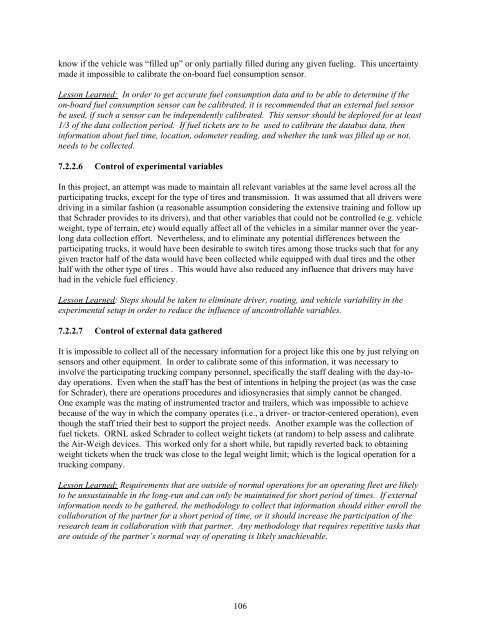Class-8 Heavy Truck Duty Cycle Project Final Report - Center for ...
Class-8 Heavy Truck Duty Cycle Project Final Report - Center for ...
Class-8 Heavy Truck Duty Cycle Project Final Report - Center for ...
You also want an ePaper? Increase the reach of your titles
YUMPU automatically turns print PDFs into web optimized ePapers that Google loves.
know if the vehicle was “filled up” or only partially filled during any given fueling. This uncertainty<br />
made it impossible to calibrate the on-board fuel consumption sensor.<br />
Lesson Learned: In order to get accurate fuel consumption data and to be able to determine if the<br />
on-board fuel consumption sensor can be calibrated, it is recommended that an external fuel sensor<br />
be used, if such a sensor can be independently calibrated. This sensor should be deployed <strong>for</strong> at least<br />
1/3 of the data collection period. If fuel tickets are to be used to calibrate the databus data, then<br />
in<strong>for</strong>mation about fuel time, location, odometer reading, and whether the tank was filled up or not,<br />
needs to be collected.<br />
7.2.2.6 Control of experimental variables<br />
In this project, an attempt was made to maintain all relevant variables at the same level across all the<br />
participating trucks, except <strong>for</strong> the type of tires and transmission. It was assumed that all drivers were<br />
driving in a similar fashion (a reasonable assumption considering the extensive training and follow up<br />
that Schrader provides to its drivers), and that other variables that could not be controlled (e.g. vehicle<br />
weight, type of terrain, etc) would equally affect all of the vehicles in a similar manner over the yearlong<br />
data collection ef<strong>for</strong>t. Nevertheless, and to eliminate any potential differences between the<br />
participating trucks, it would have been desirable to switch tires among those trucks such that <strong>for</strong> any<br />
given tractor half of the data would have been collected while equipped with dual tires and the other<br />
half with the other type of tires . This would have also reduced any influence that drivers may have<br />
had in the vehicle fuel efficiency.<br />
Lesson Learned: Steps should be taken to eliminate driver, routing, and vehicle variability in the<br />
experimental setup in order to reduce the influence of uncontrollable variables.<br />
7.2.2.7 Control of external data gathered<br />
It is impossible to collect all of the necessary in<strong>for</strong>mation <strong>for</strong> a project like this one by just relying on<br />
sensors and other equipment. In order to calibrate some of this in<strong>for</strong>mation, it was necessary to<br />
involve the participating trucking company personnel, specifically the staff dealing with the day-today<br />
operations. Even when the staff has the best of intentions in helping the project (as was the case<br />
<strong>for</strong> Schrader), there are operations procedures and idiosyncrasies that simply cannot be changed.<br />
One example was the mating of instrumented tractor and trailers, which was impossible to achieve<br />
because of the way in which the company operates (i.e., a driver- or tractor-centered operation), even<br />
though the staff tried their best to support the project needs. Another example was the collection of<br />
fuel tickets. ORNL asked Schrader to collect weight tickets (at random) to help assess and calibrate<br />
the Air-Weigh devices. This worked only <strong>for</strong> a short while, but rapidly reverted back to obtaining<br />
weight tickets when the truck was close to the legal weight limit; which is the logical operation <strong>for</strong> a<br />
trucking company.<br />
Lesson Learned: Requirements that are outside of normal operations <strong>for</strong> an operating fleet are likely<br />
to be unsustainable in the long-run and can only be maintained <strong>for</strong> short period of times. If external<br />
in<strong>for</strong>mation needs to be gathered, the methodology to collect that in<strong>for</strong>mation should either enroll the<br />
collaboration of the partner <strong>for</strong> a short period of time, or it should increase the participation of the<br />
research team in collaboration with that partner. Any methodology that requires repetitive tasks that<br />
are outside of the partner’s normal way of operating is likely unachievable.<br />
106
















